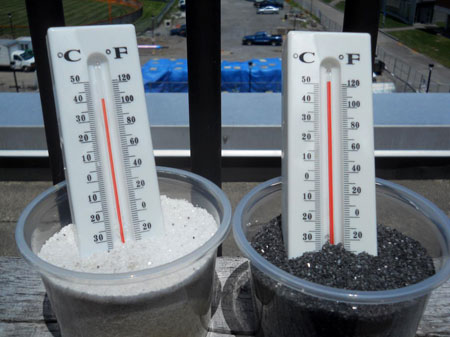
by Stephen Vermette,
Department of Geography & Planning, SUNY Buffalo State
Last week I introduced you to a weather garden, which vividly demonstrates how sunlight, temperature, wind and rain affect plants in different ways. It does this through the choice of plants, as well as through fun and useful ornaments such as thermometers, wind vanes and rain gauges.
Last week we looked at the element of sunlight. Today we will look at temperature.
In a future issue, we will look at the elements of wind and rain.
What additional plantings and ornaments would you consider for a weather garden? Please leave a comment below.
Temperature

Ornaments
A thermometer is an obvious ornamental choice in a weather garden.
To see differences in temperature in the garden, try this. Put black sand in one container and white sand in another. Place a thermometer in each (just deep enough that the thermometer bulb is in the sand). Dark surfaces tend to absorb more solar energy than light colors because light colors tend to reflect away the sun’s energy. The result is that dark surfaces tend to be warmer than light-colored surfaces. This difference in temperature is something that can be checked on while strolling in the garden.
When the sand is wet, you will notice less of a temperature difference. A wet surface adds a new variable, as some of the sun’s energy is used to evaporate water and less is used to heat the surface. Thus, evaporation is considered to be a cooling process.
Adding a water feature to the weather garden can also demonstrate this cooling effect.
Plants

Snapdragons
Snapdragons are named because of their resemblance to the face of a dragon—a dragon that can open and close its mouth when squeezed by one’s hand or when pried open by a foraging bumblebee. Snapdragons are cold-season annual plants. All plants have a base temperature, below which it does not grow. This explains why a tomato plant, planted early in the spring, does not usually grow and overtake a tomato plant planted weeks later. The snapdragon, a cold-tolerant plant with a base temperature of 36 degrees Fahrenheit can be planted early in the garden (before many other annuals) and it is one of the last annuals to succumb to frost – blooming even when snow covered.
Pansies
Pansies fall into a similar category, hardy in cool weather because they are able to survive light freezes and short periods of snow cover. For this reason, they are one of the most popular cool weather annuals, and thus one of the first plantings in the garden. They are not heat tolerant, and are often replaced in the garden with the approach of summer.
Daffodil, tulip, pussy willows, forsythia
Daffodils, tulips, pussy willows and forsythia, among others, provide a twist on temperature dependence. These plants require a minimum number of chilling hours through the winter before they can break dormancy. This chilling requirement protects the plants from emerging too soon in the spring.
Four o’clocks
Four o’clocks (beauty-of-the-night) produce small trumpet-shaped flowers that open each afternoon. After blooming, they remain open until morning. They are seeking nocturnal pollinators and are a favorite of late-foraging hummingbirds. Rather than light levels bringing them into bloom, as with morning glory or the moon flower, they are actually responding to the temperature change of cooling temperatures in the late afternoon. If the plant’s buds do not appear to bloom at 4 p.m., it is likely too warm – the blossoms do not like the heat! If the blooms don’t open, check later in the afternoon or in the evening when the air is cooler. A curious aspect of this plant is that flowers of different colors can be found simultaneously on the same plant, a variety of color patterns can be found on individual flowers, and that a flower can change its color over time. Certainly a reason to check this plant out!
Chrysanthemum
With the passing of summer, many gardeners plant a second or fall garden. The diva of the fall garden is the chrysanthemum (mum) with its fall colors of vibrant yellow, orange, burgundy or lavender that bloom profusely in the cool fall air. The plant resists light frosts and the blooms last for weeks. Reduced light in the fall stimulates the mum plant to create its fantastic blooms, as the longer nights remind the plant that winter is coming.

Ornamental cabbage
Ornamental cabbage is a cool-season, ornamental plant. Once night temperatures stay at or below 50 degrees Fahrenheit, the heart of the flowering cabbage will darken, transforming from green to bold colors of purple or white. These plants can survive early frosts, offering color during the garden’s quiet seasons of late fall and early winter. Even frozen, these plants can look good through the early part of winter.
Rhododendron
With the rhododendron, the emphasis in the weather garden is not summer, but winter. When temperatures are above freezing, the leaves of the rhododendron extend out at approximate right angles from their stems. However, during the cold days of winter, the leaves appear curled and hang down on the stem. Known as a thermotropic response, the leaves of the rhododendron curl and droop in response to freezing temperatures in order to protect themselves. The colder the temperature, the tighter they curl and the more they droop. You can use the degree of leaf curl and angle to estimate the outside air temperature. Test it against your outdoor thermometer!
Also see Our growing season is longer: What gardeners need to know about climate change in WNY, an article that talks about Stephen Vermette’s work that gives us more detail on how climate change is affecting various parts of Western New York.


